Numerical Simulation of Scalar Mixing and Transport through a Fishing Net Panel
Abstract
:1. Introduction
2. Methodology
2.1. The Governing Equations
2.2. Porous Media Model
2.3. Mesh Grids and Boundary Conditions
2.4. Numerical Solver
3. Model Calibration and Validation
4. Results and Discussion
4.1. Velocity Reduction and Recovery
4.2. Concentration Decay
4.3. Plume Spreading
5. Conclusions
- (1)
- The time−averaged velocity and concentration fields could be reasonably reproduced by a standard k-ε model implemented in OpenFOAM, in which the fishing net panel was treated as a porous media. The numerical model was calibrated and validated by experimental data, and the comparisons showed good agreement, indicating that the porous media schematization could reproduce the blocking effect of the net on the flow field, except for the inhomogeneous wake field at the immediate vicinity of the net panel, and the associated mass transport, with satisfactory accuracy.
- (2)
- Our simulation results showed a clear reduction in time-averaged flow velocity behind the net. At the same time, the complete recovery of velocity was observed within the downstream extent of the numerical simulations (i.e., x/M ~ 14). The flow velocity reduction tends to increase with increasing net solidity and decreasing incoming velocity in the near field. Moreover, the incoming velocity appeared to affect the flow velocity reduction more significantly than the net solidity for the range of variation covered in our study.
- (3)
- The scalar concentration decay tends to be stronger as the incoming velocity decreases, and the lateral profile of the scalar concentration exhibited self-similarity and followed Gaussian distribution, in agreement with experimental data. Furthermore, the spreading of plume width is reduced with increasing incoming velocity, but does not seem to be largely affected by the source location relative to the net when adopting the current RANS and porous media modelling approach.
Supplementary Materials
Author Contributions
Funding
Institutional Review Board Statement
Informed Consent Statement
Data Availability Statement
Conflicts of Interest
References
- Weiss, C.V.C.; Ondiviela, B.; Guanche, R.; Castellanos, O.F.; Juanes, J.A. A global integrated analysis of open sea fish farming opportunities. Aquaculture 2018, 497, 234–245. [Google Scholar] [CrossRef]
- Klebert, P.; Lader, P.; Gansel, L.; Oppedal, F. Hydrodynamic interactions on net panel and aquaculture fish cages: A review. Ocean Eng. 2013, 58, 260–274. [Google Scholar] [CrossRef]
- Venayagamoorthy, S.K.; Ku, H.; Fringer, O.B.; Chiu, A.; Naylor, R.L.; Koseff, J.R. Numerical modeling of aquaculture dissolved waste transport in a coastal embayment. Environ. Fluid Mech. 2011, 11, 329–352. [Google Scholar] [CrossRef]
- Wang, X.; Cuthbertson, A.; Gualtieri, C.; Shao, D. A review on mariculture effluent: Characterization and management Tools. Water 2020, 12, 2991. [Google Scholar] [CrossRef]
- Price, C.; Black, K.D.; Hargrave, B.T.; Morris, J.A., Jr. Marine cage culture and the environment: Effects on water quality and primary production. Aquac. Environ. Interact. 2015, 6, 151–174. [Google Scholar] [CrossRef] [Green Version]
- Suzuki, K.; Takagi, T.; Shimizu, T.; Hiraishi, T.; Yamamoto, K.; Nashimoto, K. Validity and visualization of a numerical model used to determine dynamic configurations of fishing nets. Fish. Sci. 2003, 69, 695–705. [Google Scholar] [CrossRef] [Green Version]
- Shao, D.; Huang, L.; Wang, R.Q.; Gualtieri, C.; Cuthbertson, A. Flow turbulence characteristics and mass transport in the near-wake region of an aquaculture cage net panel. Water 2021, 13, 294. [Google Scholar] [CrossRef]
- Zeng, X.; Gualtieri, C.; Cuthbertson, A.; Shao, D. Experimental study of flow and mass transport in the near-wake region of a rigid planar metal net panel. Aquac. Eng. 2022, 98, 102267. [Google Scholar] [CrossRef]
- Lee, C.W.; Kim, Y.B.; Lee, G.H.; Choe, M.Y.; Lee, M.K.; Koo, K.Y. Dynamic simulation of a fish cage system subjected to currents and waves. Ocean Eng. 2008, 35, 1521–1532. [Google Scholar] [CrossRef]
- Cha, B.J.; Kim, H.Y.; Bae, J.H.; Yang, Y.S.; Kim, D.H. Analysis of the hydrodynamic characteristics of chain-link woven copper alloy nets for fish cages. Aquac. Eng. 2013, 56, 79–85. [Google Scholar] [CrossRef]
- Bi, C.W.; Zhao, Y.P.; Dong, G.H.; Xu, T.J.; Gui, F.K. Experimental investigation of the reduction in flow velocity downstream from a fishing net. Aquac. Eng. 2013, 57, 71–81. [Google Scholar] [CrossRef]
- Cuthbertson, A.J.S.; Malcangio, D.; A Davies, P.; Mossa, M. The influence of a localised region of turbulence on the structural development of a turbulent, round, buoyant jet. Fluid Dyn. Res. 2006, 38, 683–698. [Google Scholar] [CrossRef]
- Nakamura, I.; Sakai, Y.; Miyata, A. Diffusion of matter by a non-buoyant plume in grid-generated turbulence. J. Fluid Mech. 1987, 178, 379–408. [Google Scholar] [CrossRef]
- Nedić, J.; Tavoularis, S. Measurements of passive scalar diffusion downstream of regular and fractal grids. J. Fluid Mech. 2016, 800, 358–386. [Google Scholar] [CrossRef]
- Rummel, A.C.; Socolofsky, S.A.; Carmer, C.F.V.; Jirka, G.H. Enhanced diffusion from a continuous point source in shallow free-surface flow with grid turbulence. Phys. Fluids 2005, 17, 075105. [Google Scholar] [CrossRef]
- Lemoine, F.; Antoine, Y.; Wolff, M.; Lebouche, M. Mass transfer properties in a grid generated turbulent flow: Some experimental investigations about the concept of turbulent diffusivity. Int. J. Heat Mass Transf. 1998, 41, 2287–2295. [Google Scholar] [CrossRef]
- Lemoine, F.; Wolff, M.; Lebouché, M. Experimental investigation of mass transfer in a grid-generated turbulent flow using combined optical methods. Int. J. Heat Mass Transf. 1997, 40, 3255–3266. [Google Scholar] [CrossRef]
- Patursson, Ø.; Swift, M.R.; Tsukrov, I.; Simonsen, K.; Baldwin, K.; Fredriksson, D.W.; Celikkol, B. Development of a porous media model with application to flow through and around a net panel. Ocean Eng. 2010, 37, 314–324. [Google Scholar] [CrossRef]
- Zhao, Y.P.; Bi, C.W.; Dong, G.H.; Gui, F.K.; Cui, Y.; Guan, C.T.; Xu, T.J. Numerical simulation of the flow around fishing plane nets using the porous media model. Ocean Eng. 2013, 62, 25–37. [Google Scholar] [CrossRef]
- Bi, C.W.; Zhao, Y.P.; Dong, G.H.; Xu, T.J.; Gui, F.K. Numerical simulation of the interaction between flow and flexible nets. J. Fluids Struct. 2014, 45, 180–201. [Google Scholar] [CrossRef]
- Tang, H.; Bruno Thierry, N.N.; Pandong, A.N.; Sun, Q.; Xu, L.; Hu, F.; Zou, B. Hydrodynamic and turbulence flow characteristics of fishing nettings made of three twine materials at small attack angles and low Reynolds numbers. Ocean Eng. 2022, 249, 110964. [Google Scholar] [CrossRef]
- Santo, H. On the application of current blockage model to steady drag force on fish net. Aquac. Eng. 2022, 97, 102226. [Google Scholar] [CrossRef]
- Løland, G. Current forces on, and water flow through and around, floating fish farms. Aquac. Int. 1993, 1, 72–89. [Google Scholar] [CrossRef]
- Tu, G.; Liu, H.; Ru, Z.; Shao, D.; Yang, W.; Sun, T.; Wang, H.; Gao, Y. Numerical analysis of the flows around fishing plane nets using the lattice Boltzmann method. Ocean Eng. 2020, 214, 107623. [Google Scholar] [CrossRef]
- Batchelor, G.K. The Theory of Homogeneous Turbulence; Cambridge University Press: Cambridge, UK, 1953. [Google Scholar]
- Gorle, J.; Terjesen, B.; Summerfelt, S. Influence of inlet and outlet placement on the hydrodynamics of culture tanks for Atlantic salmon. Int. J. Mech. Sci. 2020, 188, 105944. [Google Scholar] [CrossRef]
- Pope, S.B. Turbulent Flows; Cambridge University Press: Cambridge, UK, 2000; p. 771. [Google Scholar]
- Patursson, Ø.E.; Swift, M.R.; Tsukrov, I.; Baldwin, K.; Simonsen, K. Modeling flow through and around a net panel using computational fluid dynamics. In Proceedings of the OCEANS, Boston, MA, USA, 18–21 September 2006; pp. 1–5. [Google Scholar]
- Launder, B.E.; Spalding, D.B. The numerical computation of turbulent flows. Comput. Methods Appl. Mech. Eng. 1974, 3, 269–289. [Google Scholar] [CrossRef]
- Burcharth, H.F.; Andersen, O.H. On the one-dimensional steady and unsteady porous flow equations. Coast. Eng. 1995, 24, 233–257. [Google Scholar] [CrossRef]
- Chen, H.; Christensen, E.D. Investigations on the porous resistance coefficients for fishing net structures. J. Fluids Struct. 2016, 65, 76–107. [Google Scholar] [CrossRef] [Green Version]
- Morison, J.R.; Johnson, J.W.; O’Brien, M.P.; Schaaf, S.A. The forces exerted by surface waves on piles. Pet. Trans. Am. Inst. Min. Eng. 1950, 189, 149–154. [Google Scholar] [CrossRef]
- OpenCFD. OpenFOAM: The Open Source CFD Toolbos Programmer’s Guide; OpenCFD Ltd.: Bracknell, UK, 2018. [Google Scholar]
- Rodi, W. Turbulence Models and Their Application in Hydraulics—A State of the Art Review, 3rd ed.; IAHR Monograph: Delft, The Netherlands, 1993; p. 104. [Google Scholar]
- Issa, R. Solution of the implicit discretized fluid flow equations by operator splitting. J. Comput. Phys. 1986, 62, 40–65. [Google Scholar] [CrossRef]
- Van Leer, B. Toward the ultimate conservative difference scheme. Part IV: A new approach to numerical convection. J. Comput. Phys. 1979, 23, 276–299. [Google Scholar] [CrossRef]
- Aarsnes, J.V.; Rudi, H.; Løland, G. Current Forces on Cage, Net Deflection; Thomas Telford: London, UK, 1990; pp. 137–152. [Google Scholar]
- Launder, B.E.; Spalding, D.B. Lectures in Mathematical Model of Turbulence; Academic Press: London, UK, 1972; Available online: https://www.semanticscholar.org/paper/Lectures-in-mathematical-models-of-turbulence-Launder-Spalding/19dad37ff5b1f0ae15b067758ec5a47e8692c840 (accessed on 25 August 2022).
- Gualtieri, C.; Angeloudis, A.; Bombardelli, F.; Jha, S.; Stoesser, T. On the Values for the Turbulent Schmidt Number in Environmental Flows. Fluids 2017, 2, 17. [Google Scholar] [CrossRef] [Green Version]
- Zhan, J.M.; Jia, X.P.; Li, Y.S.; Sun, M.G.; Guo, G.X.; Hu, Y.Z. Analytical and experimental investigation of drag on nets of fish cages. Aquac. Eng. 2006, 35, 91–101. [Google Scholar] [CrossRef]
- Milne, P.H. Fish and Shellfish Farming in Coastal Waters; Fishing News: London, UK, 1972. [Google Scholar]
- Cornejo, P.; Sepúlveda, H.H.; Gutiérrez, M.H.; Olivares, G. Numerical studies on the hydrodynamic effects of a salmon farm in an idealized environment. Aquaculture 2014, 430, 195–206. [Google Scholar] [CrossRef]
- Yao, Y.; Chen, Y.; Zhou, H.; Yang, H. Numerical modeling of current loads on a net cage considering fluid–structure interaction. J. Fluids Struct. 2016, 62, 350–366. [Google Scholar] [CrossRef]
- Warhaft, Z. The interference of thermal fields from line sources in grid turbulence. J. Fluid Mech. 1984, 144, 363–387. [Google Scholar] [CrossRef]
- Zenklusen, A.; Kenjereš, S.; Rohr, P. Mixing at high Schmidt number in a complex porous structure. Chem. Eng. Sci. 2016, 150, 74–84. [Google Scholar] [CrossRef]
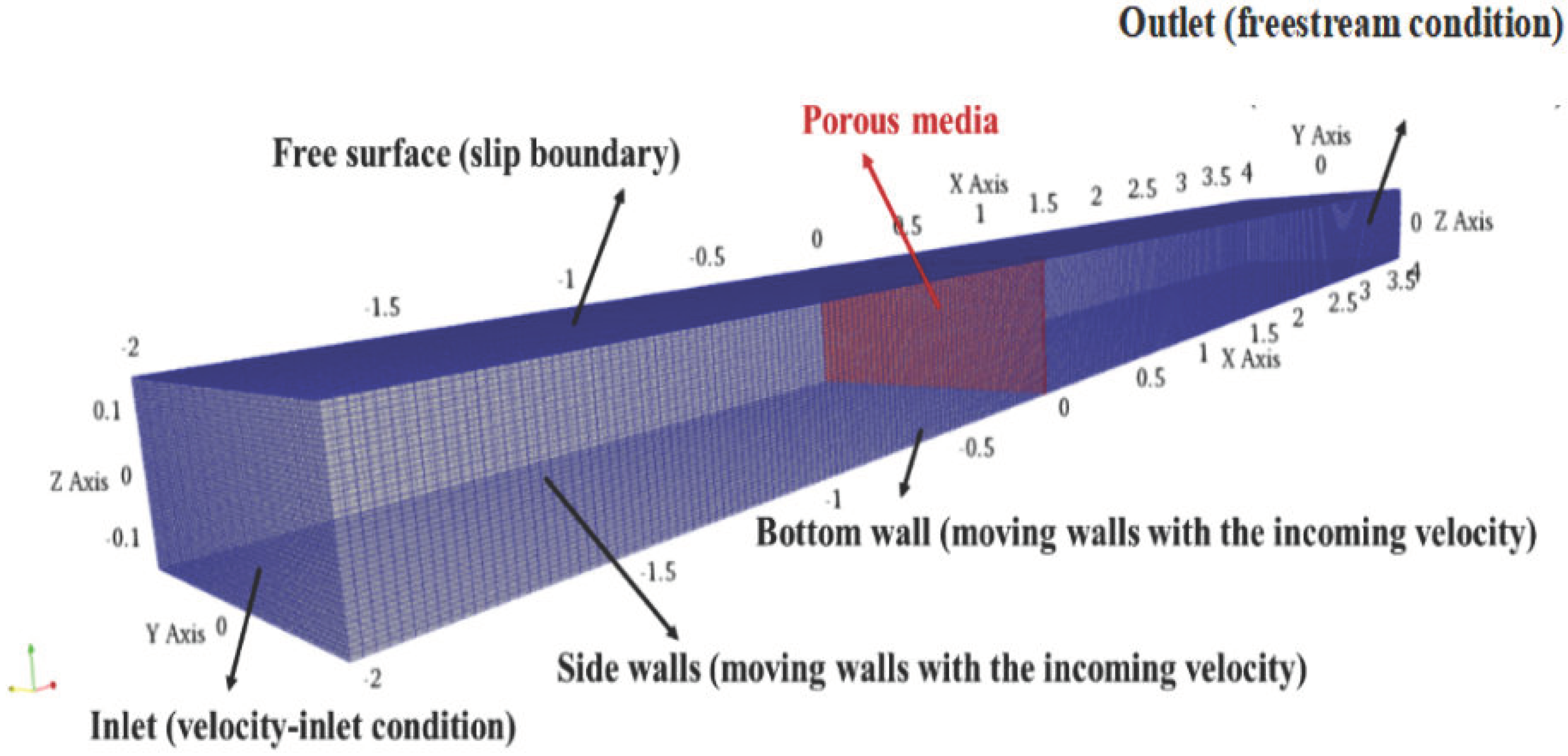
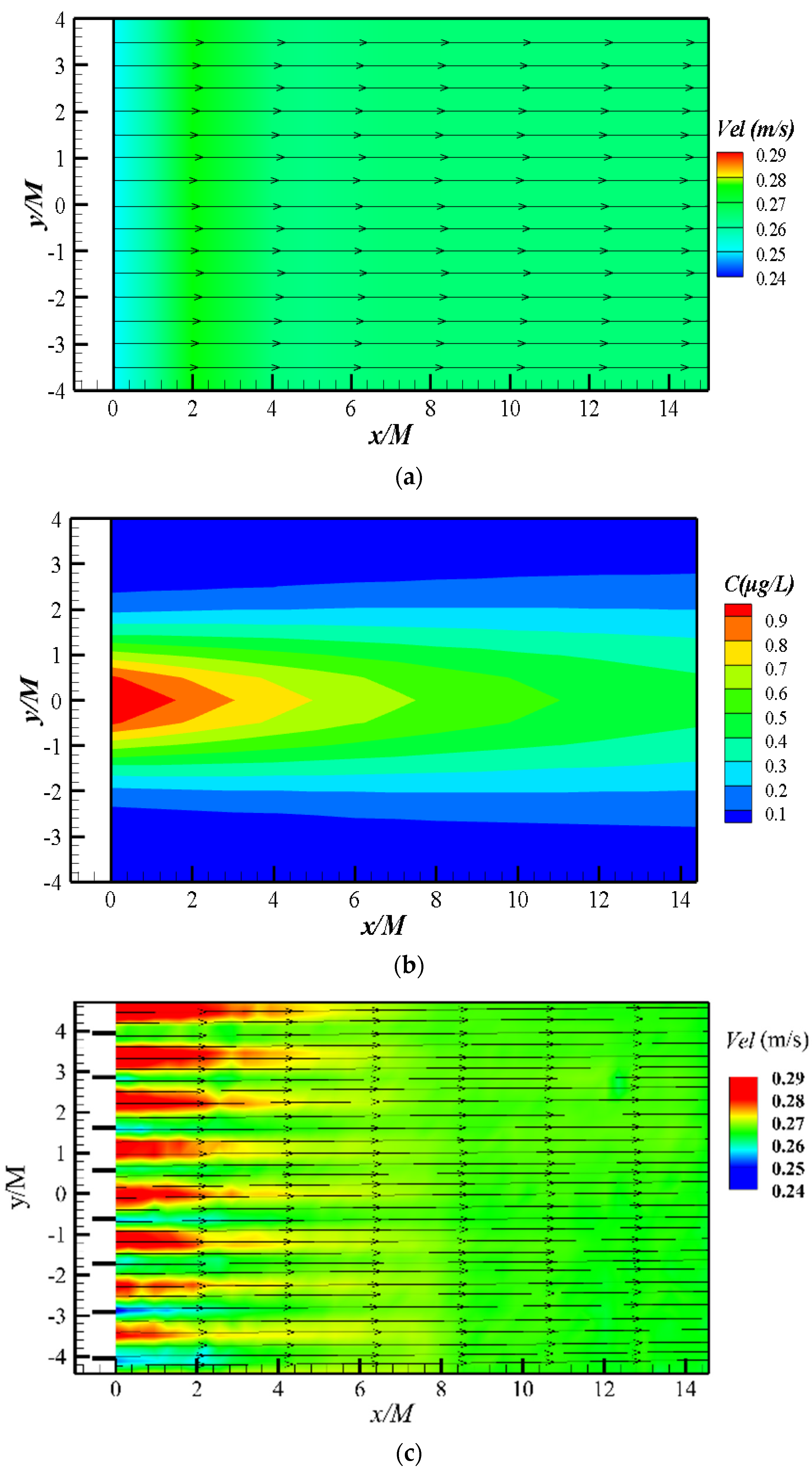
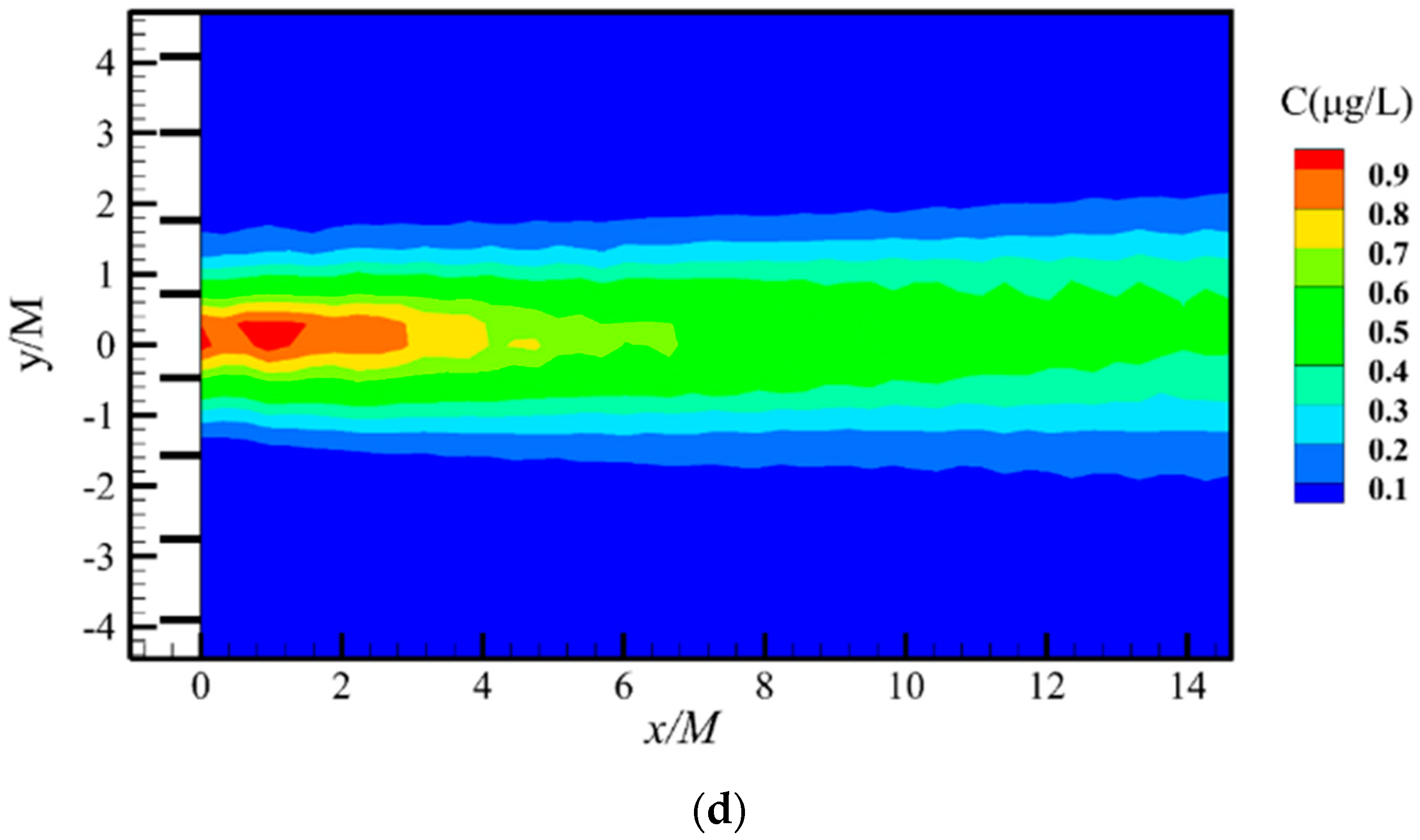
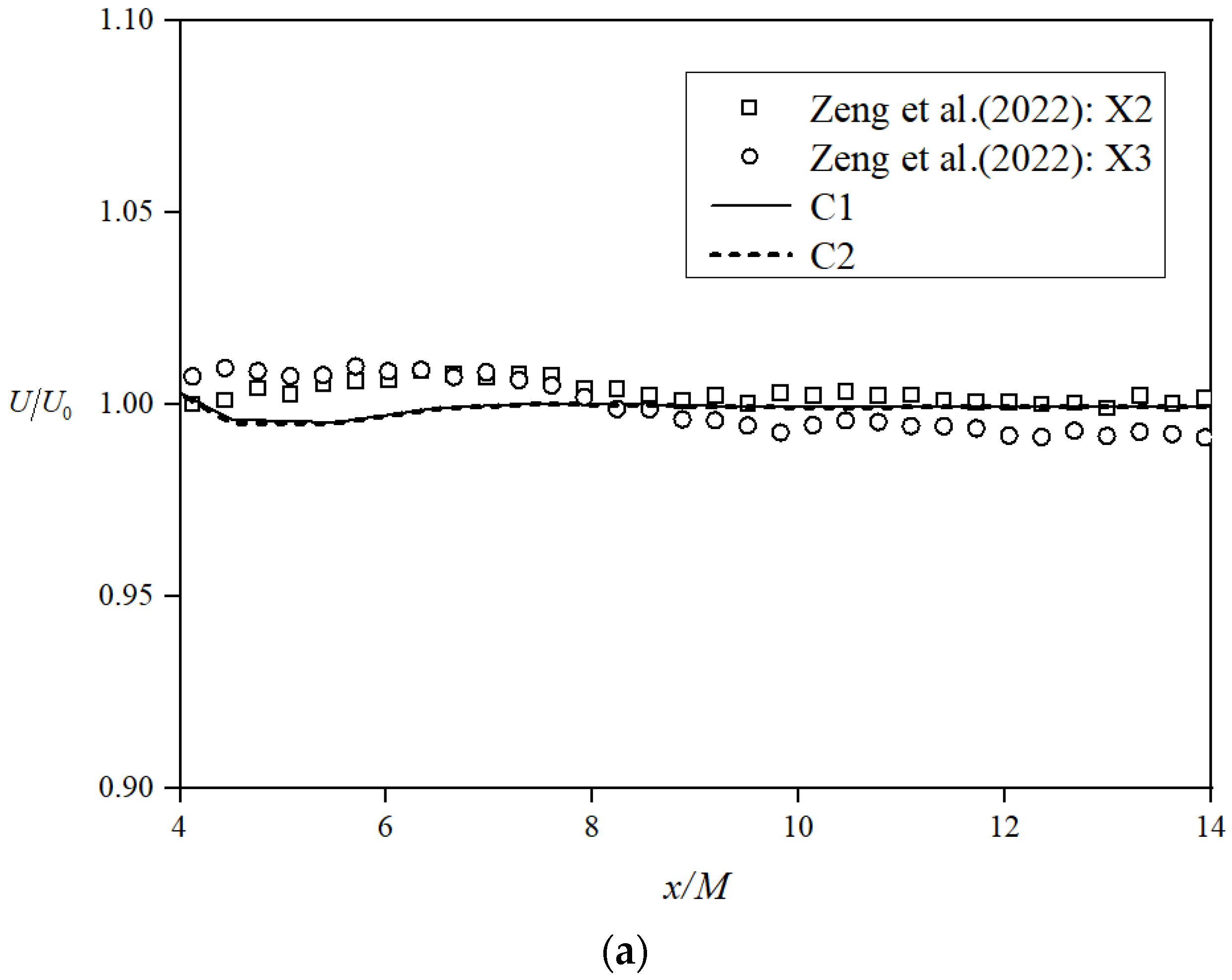
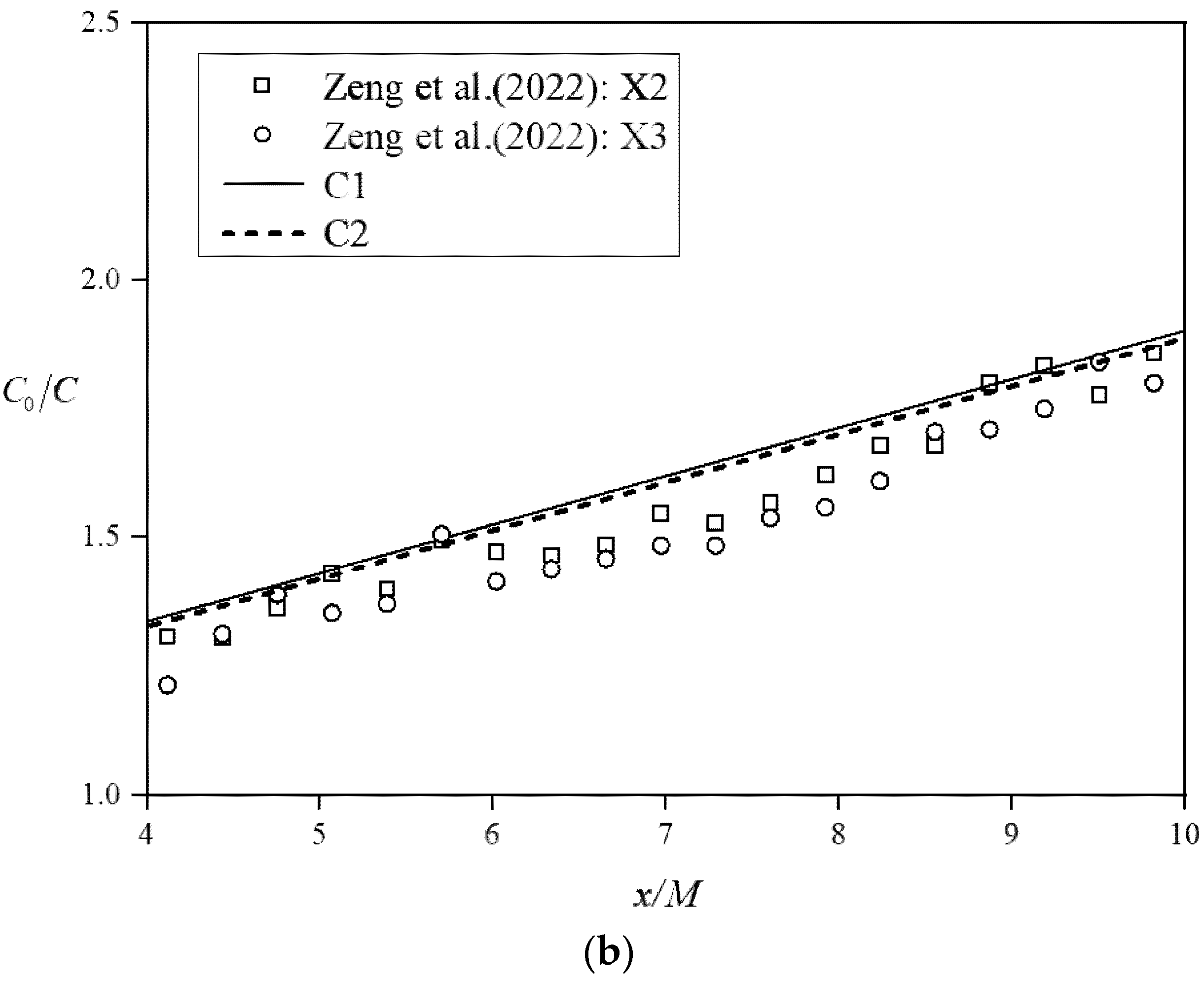
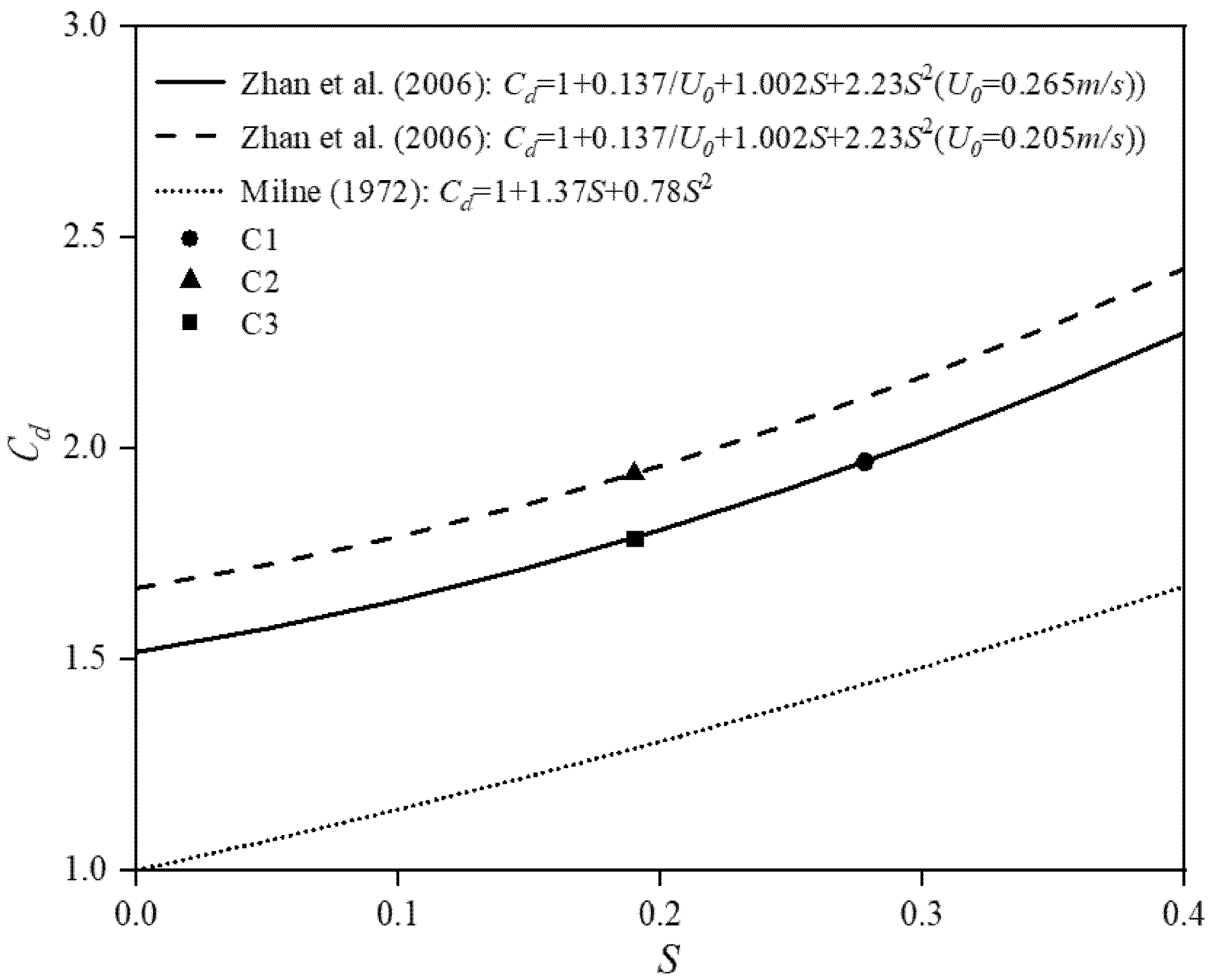
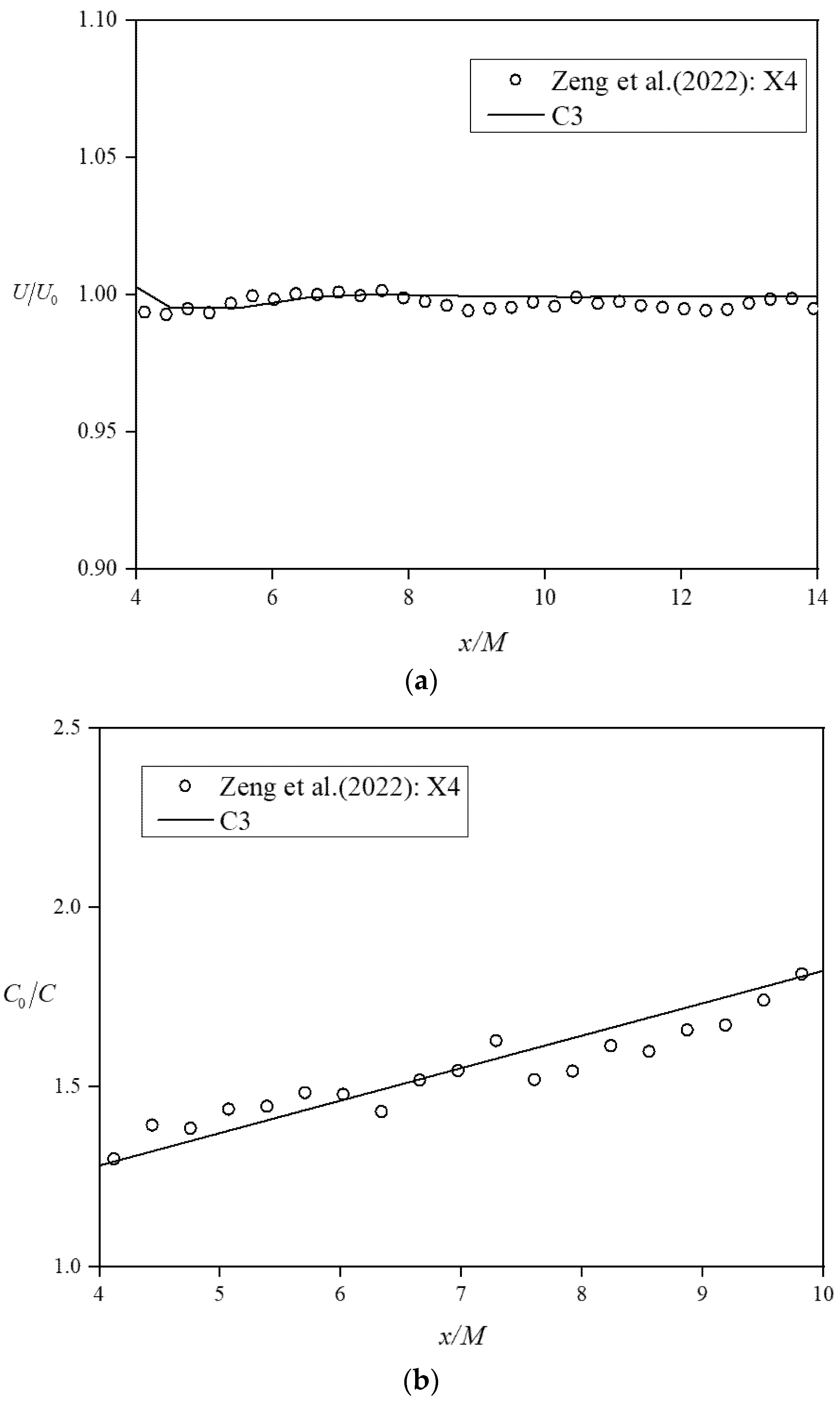
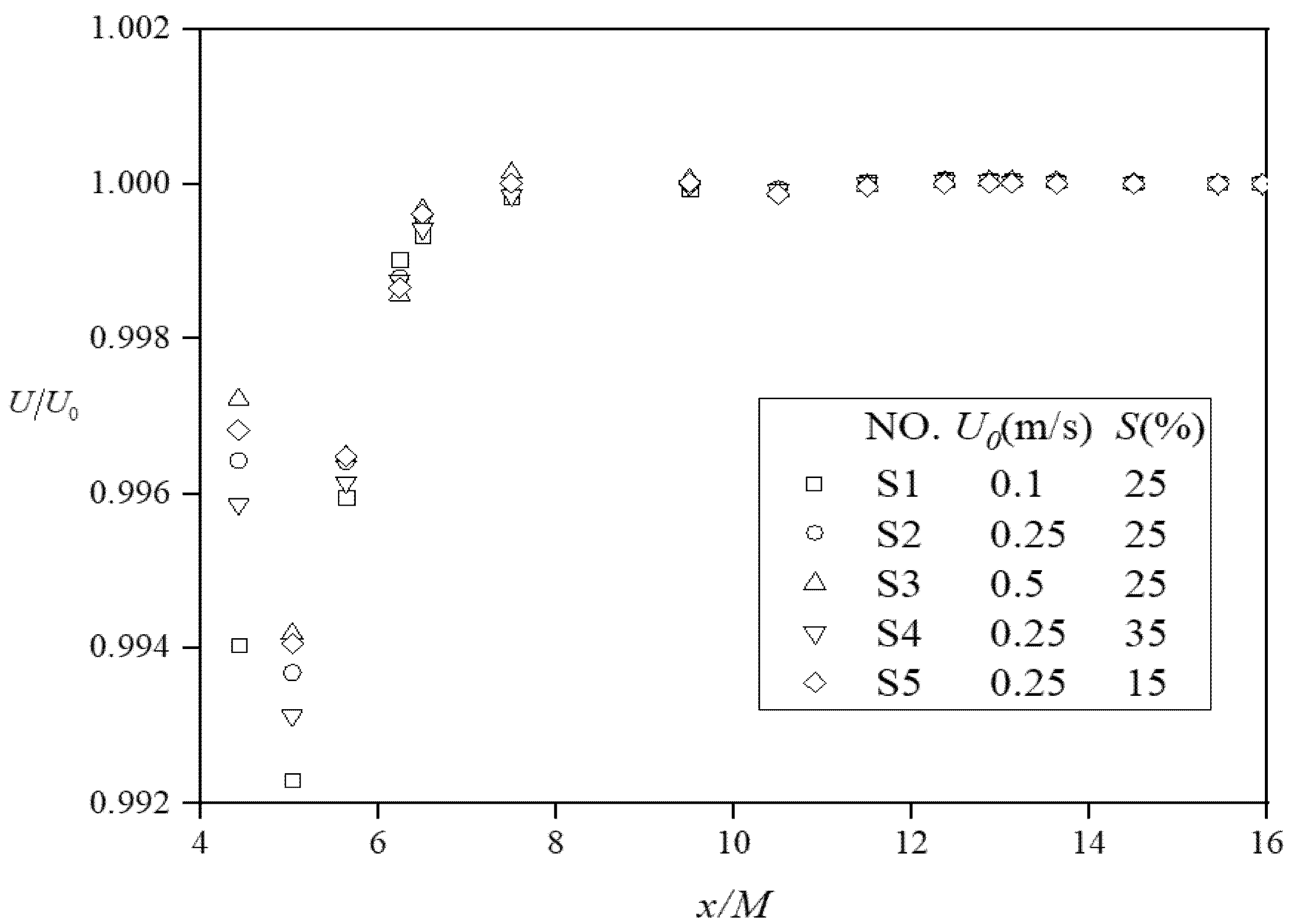

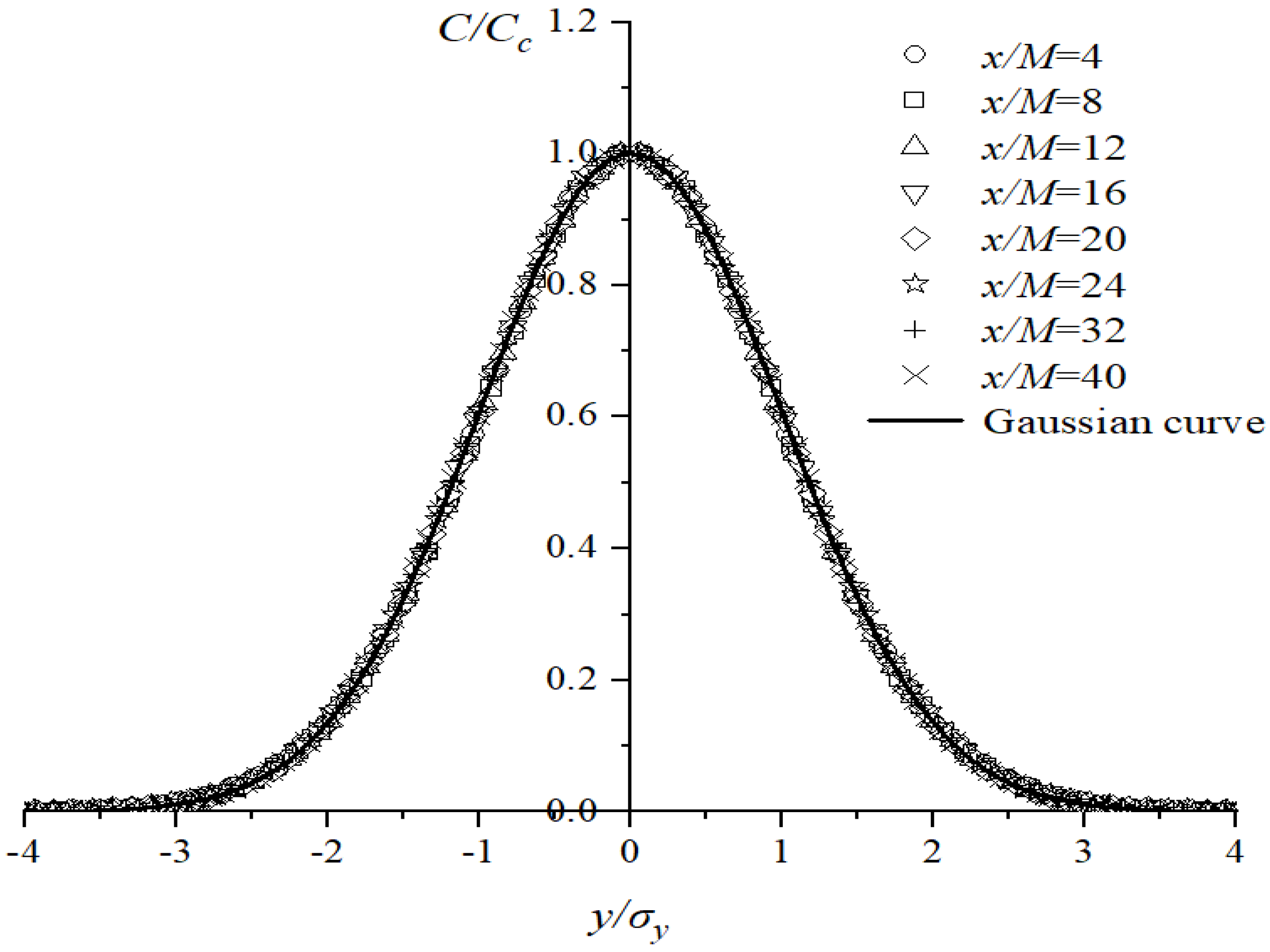
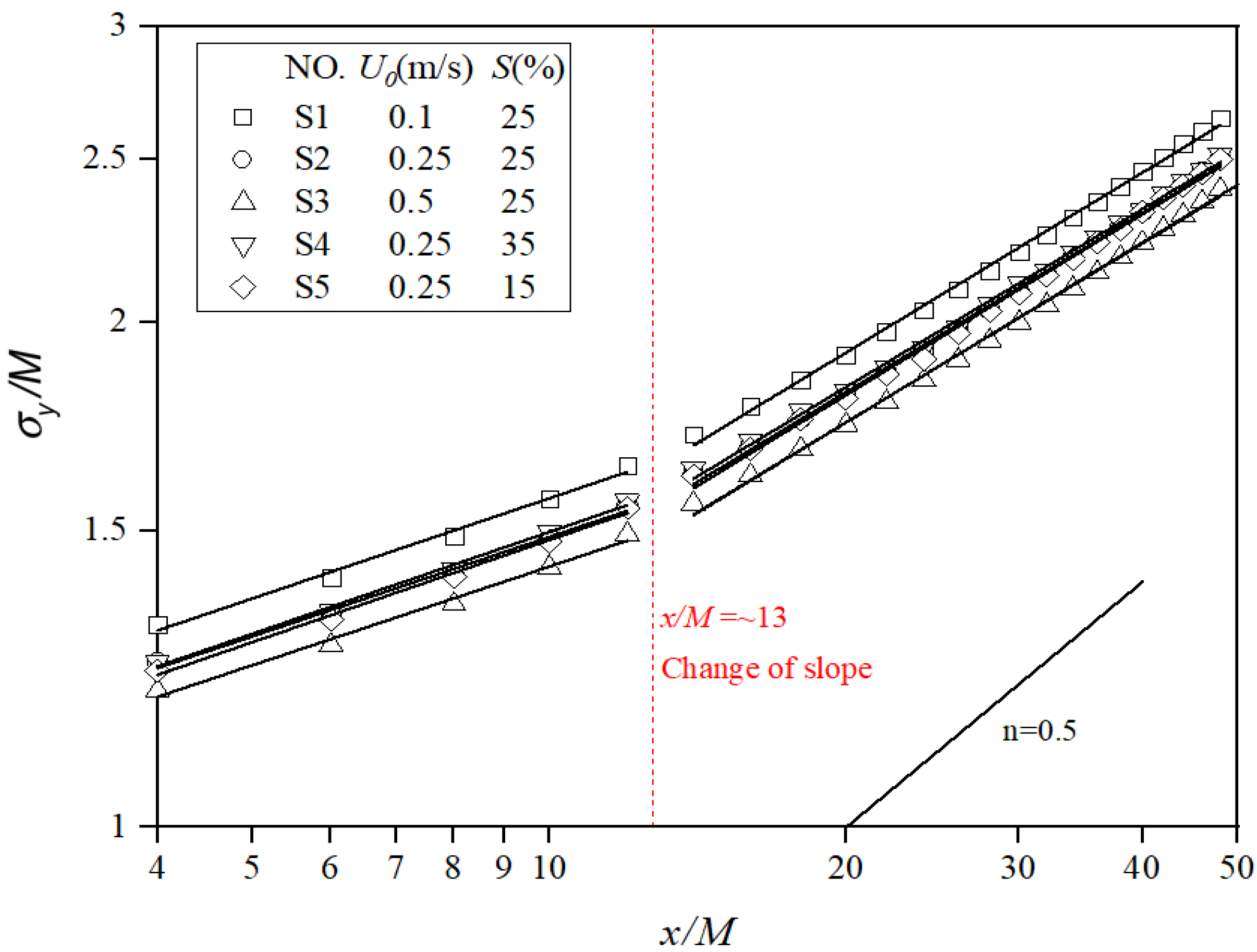
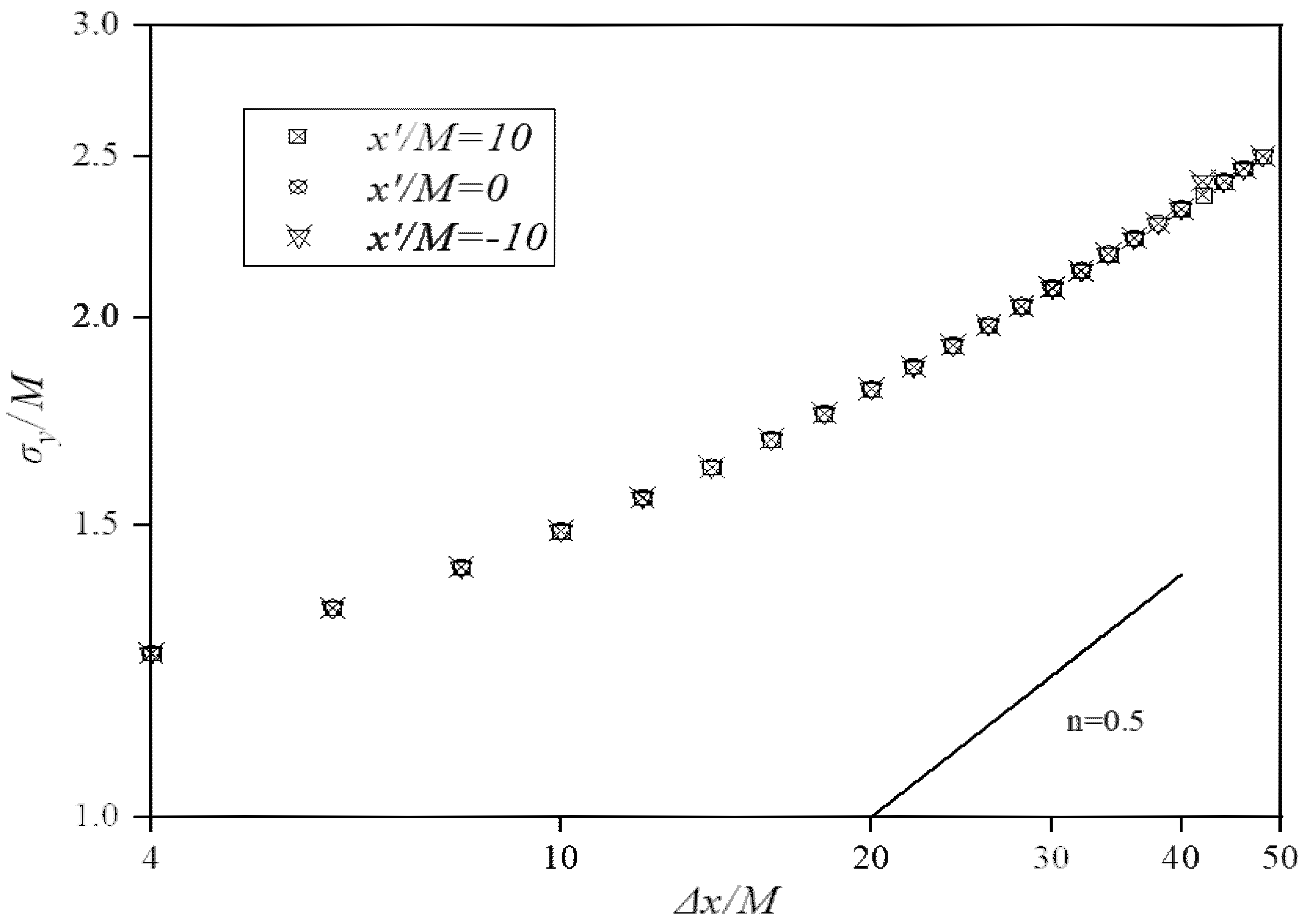
| No. | Incoming Velocity U0 (m/s) | Turbulent Kinetic Energy k (m2/s2) | Turbulence Dissipation Rate ε (m2/s3) | Net Solidity S (%) | Porous Resistance Coefficient Cn (m−1) | Time Step Δt | Simulation Time T (s) |
|---|---|---|---|---|---|---|---|
| C1 | 0.265 | 1.31 × 10−4 | 5.1 × 10−6 | 19.0 | 44.7 | 0.02 | 40 |
| C2 | 0.265 | 1.31 × 10−4 | 5.1 × 10−6 | 27.8 | 49.2 | 0.02 | 40 |
| C3 | 0.205 | 8.33 × 10−5 | 2.6 × 10−6 | 19.0 | 48.5 | 0.02 | 40 |
| S1 | 0.1 | 2.37 × 10−5 | 3.95 × 10−7 | 25.0 | 69 | 0.02 | 60 |
| S2 | 0.25 | 1.18 × 10−4 | 4.38 × 10−6 | 25.0 | 48.4 | 0.02 | 40 |
| S3 | 0.5 | 3.97 × 10−4 | 2.7 × 10−5 | 25.0 | 41.6 | 0.01 | 30 |
| S4 | 0.25 | 1.18 × 10−4 | 4.38 × 10−6 | 35.0 | 54.3 | 0.02 | 40 |
| S5 | 0.25 | 1.18 × 10−4 | 4.38 × 10−6 | 15.0 | 43.7 | 0.02 | 40 |
Publisher’s Note: MDPI stays neutral with regard to jurisdictional claims in published maps and institutional affiliations. |
© 2022 by the authors. Licensee MDPI, Basel, Switzerland. This article is an open access article distributed under the terms and conditions of the Creative Commons Attribution (CC BY) license (https://creativecommons.org/licenses/by/4.0/).
Share and Cite
Yang, X.; Zeng, X.; Gualtieri, C.; Cuthbertson, A.; Wang, R.-Q.; Shao, D. Numerical Simulation of Scalar Mixing and Transport through a Fishing Net Panel. J. Mar. Sci. Eng. 2022, 10, 1511. https://doi.org/10.3390/jmse10101511
Yang X, Zeng X, Gualtieri C, Cuthbertson A, Wang R-Q, Shao D. Numerical Simulation of Scalar Mixing and Transport through a Fishing Net Panel. Journal of Marine Science and Engineering. 2022; 10(10):1511. https://doi.org/10.3390/jmse10101511
Chicago/Turabian StyleYang, Xinyue, Xianglai Zeng, Carlo Gualtieri, Alan Cuthbertson, Ruo-Qian Wang, and Dongdong Shao. 2022. "Numerical Simulation of Scalar Mixing and Transport through a Fishing Net Panel" Journal of Marine Science and Engineering 10, no. 10: 1511. https://doi.org/10.3390/jmse10101511
APA StyleYang, X., Zeng, X., Gualtieri, C., Cuthbertson, A., Wang, R.-Q., & Shao, D. (2022). Numerical Simulation of Scalar Mixing and Transport through a Fishing Net Panel. Journal of Marine Science and Engineering, 10(10), 1511. https://doi.org/10.3390/jmse10101511








